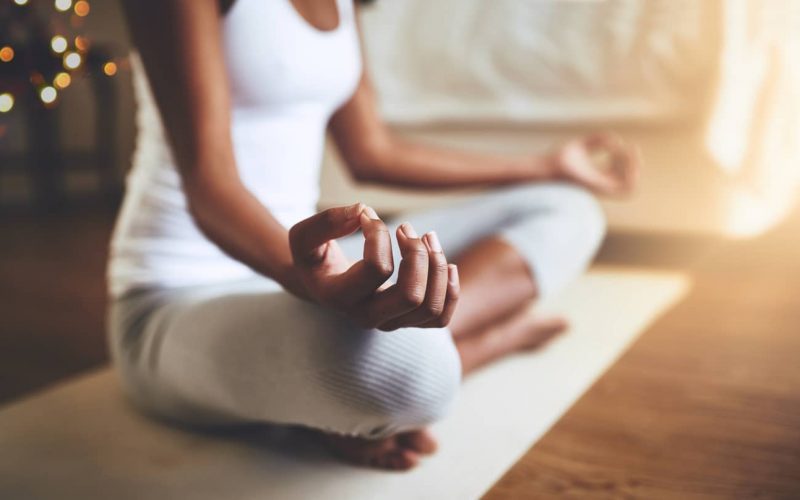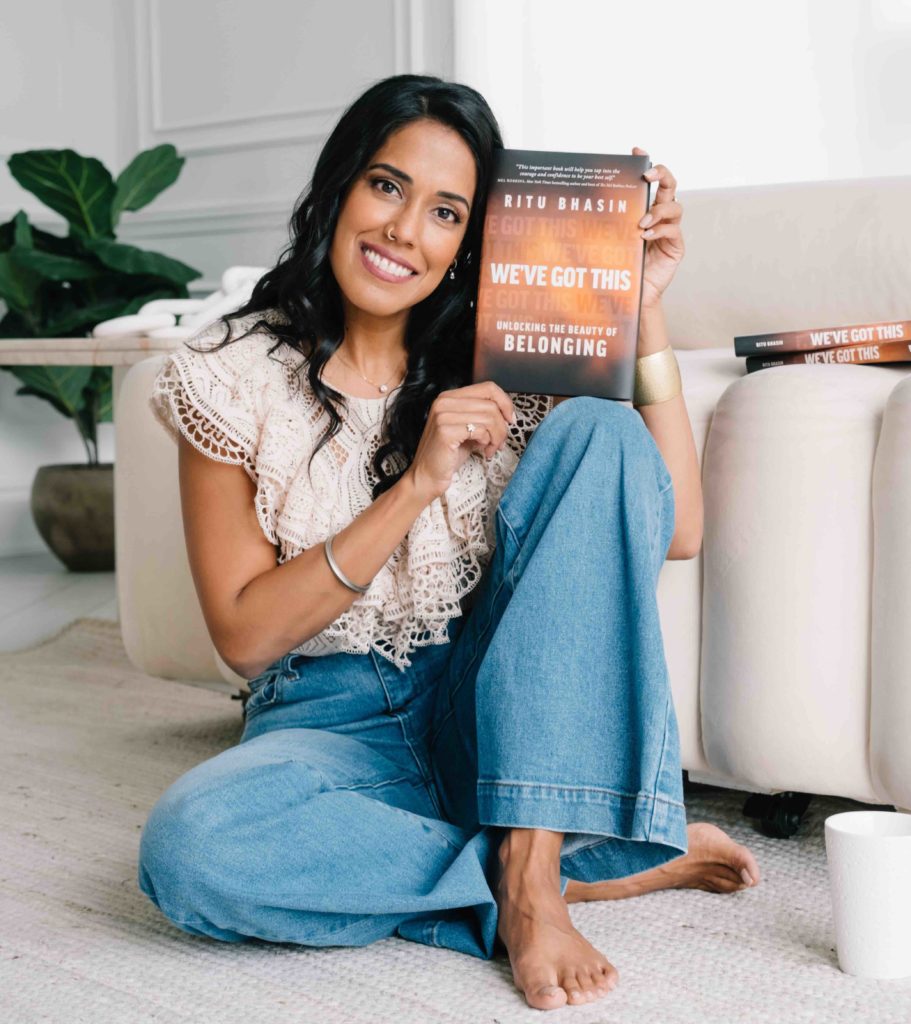
I’m sure you’re hearing truckloads about the importance of mindfulness, but what does this important concept actually mean?!
In my work, I explain that mindfulness is all about tuning into the present moment to gain awareness of what you’re thinking, feeling, and sensing, in a non-judgmental way. You don’t need Lululemons, candles, incense, sitar music, or challenging yoga positions to make it happen — and frankly, most of us just won’t do those things on a regular basis. Because of its simplicity, mindfulness is available to everyone, and there are many different ways that you can access its benefits from wherever you happen to be.
I’ve evolved in how I embed mindfulness practices into my life because of my hectic lifestyle. Ten years ago when I first started to really dig into mindfulness, I had a very structured, time-intensive sadhana (practice) which meant getting up an hour early a few times a week to meditate, do yoga, and more. Nowadays, given that I run a business that requires me to travel multiple times a week, I prioritize techniques that are simple, quick, and that I can take with me anywhere. Here are a few of my favorite ways to incorporate mindfulness into daily life.
Mindful Breathing
There is a ton of research telling us about the benefits of intentional breathing. Just paying attention to your inhales and exhales can have a calming effect, and learning how to “belly breathe” (diaphragmatic breathing, something I learned in my yoga teacher training — it’s such a gift!) is a powerful tool for managing stress and anxiety.
What I love about mindful breathing is that it’s free, can be practiced anytime and anywhere, and you’re already breathing, so you might as well do it the best way possible. It really is a “must do” — mindful breathing is clutch. It’s the one thing that I focus on as much as possible throughout the day in order to be mindful.
Try this simple exercise with your breath: take a slow, full inhale through your nose, pushing your belly out and filling your lungs to the bottom. On your exhale, pull your belly all the way in, causing the air right from the bottom of your lungs to be pushed up through your mid-chest to your upper chest, and then out.
Incorporating this simple breathing exercise into your day alone will help you to become more present!
Sitting
Sitting with good posture is critical because it impacts how you breathe. Essentially, the better you sit, the better you will be able to engage in deep breathing both consciously and unconsciously. Many of us spend most of our time sitting — whether we’re at work or on the couch Netflixing (ha!). If this applies to you, it’s especially beneficial for you to be mindful of how your body is positioned while you’re sitting.
Ideally, you want to sit with your spine straight and your shoulders relaxed with your feet flat on the floor. I find that either sitting on or against a cushion in my chair keeps me aware of my posture. (I was gifted a cushion from REALthings, and I’m loving it!)
Essential Oils
A few years ago, a girlfriend of mine gave me a bottle of “stress relief” roll-on lavender-scented oil to help me manage stress. Who knew that it would be life changing?!
Some studies have shown a range of benefits to using essential oils for aromatherapy, including relief from stress and better sleep. I’ve found that when I apply lavender oil throughout the day under my nose (and sometimes even right on my nostrils), not only do I smell great (ha!), but I also get the benefits of aromatherapy. Most importantly, it causes me to breathe more deeply (because I love the smell), so I receive the benefits of deep breathing more often. When I do this, I start to relax and generally feel better.
Simple Meditation
Like many, I find it hard to take 20-30 minutes each day to meditate. But one of the key lessons I’ve learned in practicing mindfulness is that it isn’t all or nothing. We do the best we can. For me what works is to meditate each morning when I first wake up — and I do it for 1-11 minutes depending on how I feel and how much time I have (and let’s just say, if I’ve been out partying the night before and I’m running late, it likely ain’t gonna happen!). Usually, I end up meditating for about 3-5 minutes.
My current practice is super simple, and I have deliberately designed it as such. I need something that works for me, and this does: I sit up in bed cross-legged with a straight spine, set the timer for as many minutes as I can devote to it, close my eyes, and repeat my mantra (I use satnam, which in the Sikh faith means “there is only one constant”). When the timer goes off, I spend a minute or two expressing my thanks, gratitude, and intention for the day (all done in my head, to myself).
This is my personal practice, but it can be as simple as closing your eyes and observing your breath for 2 minutes. The key point here is to experiment and find what works for you.
Expressions of Gratitude
Much has been written about the importance of gratitude — not just for cultivating joy in life, but also to help focus on present awareness. Pausing to reflect on what you are grateful for will push your thoughts to your present surroundings and experiences, which is so important for experiencing appreciation and interrupting fear. I express gratitude every morning when I meditate, and throughout the day when I am reminded to do so.
It’s helpful to embed your day with triggers that will remind you to take a moment to be grateful. For me, whenever I look at the clock and it says 11:11 or 1:11, I use this as a reminder to take a pause and express gratitude for what I’m thankful for in the moment. (Funnily enough, as I was typing just now the clock read 11:11 and I gave an expression of gratitude!)
Mindful Eating
We all carry symptoms of stress in our physical bodies. Through my own self-reflection work I’ve come to see that I carry most of my stress in my stomach/GI tract (I’ve had a lifetime of digestive issues, argh!). This is because when the body experiences stress, it goes into fight or flight mode — and one of the effects of being in this state is disrupted digestion. One way to ensure that our bodies are able to digest our food properly (and to enjoy our meals — which is critical for me as a foodie who loves to “throw down” with food) is to practice mindful eating.
I don’t care how wonky this might sound to some, because it works for me! When I’m eating, I pause to look at my food, sense its energy, express my gratitude for the meal, set my intention to digest it properly, and then I chew each bite slowly before swallowing. Eating mindfully is beneficial for our bodies (particularly our digestion), our minds, and our relationship with food.
Not every mindfulness technique will work for everyone, but if you can find just one that works for you, you’re on your way to unlocking all that mindfulness has to offer.
My takeaway question for you is, what will you do to engage in a mindfulness practice after today?

I'm Ritu.
I’m an award-winning life coach, empowerment speaker, author, and inclusion expert dedicated to helping you live your best life.

Join MY COMMUNITY
Sign up for my mailing list to get free inspiration and tools straight to your inbox!
Top Posts
Related Posts

Dig deep into your journey to belong.
Be the first to learn about my authenticity and empowerment goodies and get them straight to your inbox.






